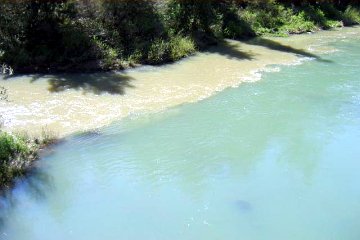~~* The Singing Falls Stream Restoration Project *~~
 ϕ
ϕ
~~*Water For Salmon*~~
You won't find salmon swimming up you shower drain--and yet your bathroom and kitchen faucets are linked to the salmon's migratory cycle.
It isn't news that fish need water. And it isn't news that a growing human population is drawing more and more water from streams and rivers for its own use. But many people don't realize how much impact an individual household can have. In a typical home, each individual uses between 70 and 90 gallons a day. Multiply that by the population of even a modest-sized town and you'll find a good portion of the neighboring stream taking a detour through a pipe. Think of the water splashing into your sink as a bit of salmon habitat.
If all the water disappears, the fish die (and that happens with some rivers). But the amount of water in the stream matters to salmon in more subtle ways, too. Juvenile salmon (“smolts”) need fast flows in the spring to help them down to the sea. Low flows in the summer make it likelier that the water will warm up to a dangerous temperature for fish. Warmer water carries less dissolved oxygen while at the same time increasing the metabolism of the young salmon. Salmon don't survive well at temperatures above 65° Fahrenheit, and usually die above 77° F.

Turbid water in elk creek from poor logging practices
If water levels drop too far in the fall or winter, they may expose the nests (“redds”) where the spawning females have deposited their eggs. And less water means less dilution of the chemicals we allow to enter the stream.
Households can do a great deal to conserve water, leaving it in the river for the salmon's migration. Among the easily accomplished steps to consider:
Check for leaks. Even a slow drip can waste 20 gallons a day. Fix leaking faucets, and check toilets for failing valves (place dye or food coloring in the tank and see if it show up in the bowl). You can inspect your entire water system for hidden leaks by turning off all faucets and checking the meter to see if it continues to show use.
Install low-flow showerheads. Not only will these save a dozen gallons or more for a typical shower, they usually pay for themselves in lower water and electric bills within a year. Low-flow aerators on faucets can save as much as 12 gallons per minute of use.
Put a water displacement device (a weighted plastic bottle will do) in every toilet; this can save gallons per flush.
Use water efficiently: Leave the faucet off while shaving or brushing teeth; use the dishwasher and washing machine only for full loads; keep showers short; while waiting for hotter or colder water from the tap, catch the spillage for watering plants or other uses; flush the toilet only when necessary not to dispose of bits of trash.
For more information on how you can help salmon recovery efforts in the Pacific Northwest, please contact your local watershed restoration group, soil and water conservation district or Pacific States Marine Fisheries Commission, 45 SE 82nd Dr., Suite 100, Gladstone, OR 97027-2522.
stream index
top






